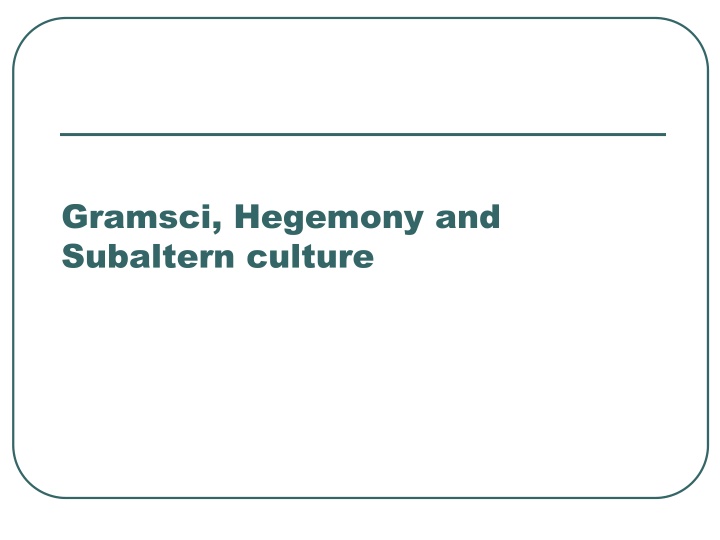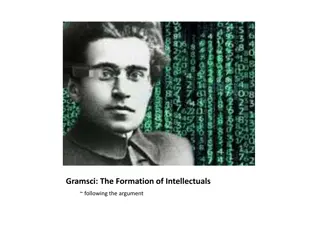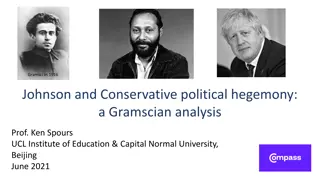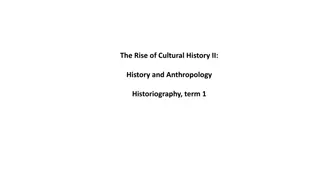
Marx and Gramsci: Analysis of Hegemony, Subaltern Culture, and Ideology
Explore the concepts of hegemony, subaltern culture, and ideology through the lens of Gramsci and Marx's analysis. Discover how economic systems shape cultural superstructures and influence societal change. Delve into the role of false consciousness and class consciousness in driving revolutionary movements.
Download Presentation

Please find below an Image/Link to download the presentation.
The content on the website is provided AS IS for your information and personal use only. It may not be sold, licensed, or shared on other websites without obtaining consent from the author. If you encounter any issues during the download, it is possible that the publisher has removed the file from their server.
You are allowed to download the files provided on this website for personal or commercial use, subject to the condition that they are used lawfully. All files are the property of their respective owners.
The content on the website is provided AS IS for your information and personal use only. It may not be sold, licensed, or shared on other websites without obtaining consent from the author.
E N D
Presentation Transcript
Gramsci, Hegemony and Subaltern culture
Marxs analysis of culture The economic base, the forces and relations of production determine the cultural superstructure of a society Forces and relations are mainly the technology and economic class relations that define an economic system Slave/owner in an ancient agricultural system Lord/serf in an advanced agricultural system, technology allowing for shared farming Bourgeoisie/proletariat in a capitalist system with the development of mechanization and factory production
Marxs approach Marx was most concerned with identifying the laws of social change based on the historical development of societies technological and economic systems His work on the superstructure presents a fairly mechanical reflection of the power held in the base Though some argue that he simply did not have enough time to articulate a more sophisticated relationship Control over the media, for example, allows the powerful to provide a nearly uniform ideological presentation across the entire society
Ideology Mostly imposed from above, with little attention to the actions of the oppressed classes Acceptance is fairly uniform, with the mind another terrain of oppression Elite ideologists are either members of the bourgeois class or employed by the class Though there are certain forms of conflict within the class, they are resolved when an issue of consequence for interclass relations emerges
Determination For Marx, false consciousness The false beliefs about their real conditions that workers subject to elite ideology have False consciousness forestalls the development of class consciousness, the learned beliefs/knowledge that allow the class member to see from the true perspective of his/her class Class consciousness leads to revolution or revolutionary consciousness as the classes are forced to recognize the irreconcilable conflict of their positions superstructure is a reflection of the real social driver, not a driver itself. The system ideology is generated through the working of the economic structure. The ideology reflects and supports that structure. But the driving force is the forces and relations of production which define the kind of culture a society will develop.
Class consciousness It is the role of the intelligentsia to lead the working class into class consciousness Only through training and exhortation can workers break through their false consciousness Inherent contradictions in the working of the base lead to crises, representing opportunities for the development of class consciousness
Issues for later theorists (neo-Marxists) The nature of false consciousness Antonio Gramsci Hegemony Subaltern classes take part in their own deception Hegemony partial, conflicted, always in flux Must constantly be won Always in danger of being undermined Hegemony not a uniform, leaden ideology representing elite interests Natural, common sense
Antonio Gramsci and hegemony Gramsci argued that diverse social groups attained hegemony at different times through inducing the consent of the majority of subordinate groups In this sense, Gramsci s hegemony relates to how the ruling class turn their ideologies into common sense and natural and how they preserved that status quo
Antonio Gramsci and hegemony continued According to Gramsci, the establishment of hegemony requires active and willing consent Common sense, suggests Geoffrey Nowell-Smith, is 'the way a subordinate class lives its subordination' (cited in Alvarado & Boyd- Barrett 1992: 51) Gramsci also emphasized struggle in his conceptualization of hegemony 'common sense is not something rigid and immobile, but is continually transforming itself' (Gramsci, cited in Hall 1982: 73) Consent must be constantly won and re-won, peoples material and social experiences remind them of their subordination, this causes a threat to the dominant ideology
Antonio Gramsci and hegemony continued Gramsci pointed out that while the unity of the prevailing groups is usually created through the state and violent institutions (American revolution, the establishment of the Turkish Republic, police, military etc.), civil society institutions play an important role in establishing and maintaining hegemony as well (schools, religion, media etc.) Later, the French Marxian thinker Louis Althusser defined these civil society institutions as ideological state apparatuses
Applying the hegemony theory Hegemony theory of Gramsci involves both analysis of current forces of domination, the ways in which these forces achieved hegemonic authority and the delineation of counter hegemonic forces that could contest the existing hegemony It is this question of counter hegemony where culture becomes essential
Later theorists Cultural Marxists work off Gramsci s analysis Ideology Entire worldview (Chomsky) Active structure for apprehending the world processing of new information according to rules that seem natural or commonsensical but in fact represent certain interests Connotative definition of language (Hall)
Superstructure The cultural superstructure is the legal system, educational system, ideology, art, media, etc. Althusser outlined a number of Ideological State Apparatuses (ISAs) that served to reproduce the conditions of production that is, the teach workers their place in the world and reproduce them as a factor in production But cannot be just a reflection of the base, rather works alongside forces of production
Theory of Cultural Studies Cultural studies situated culture within a theory of social production and reproduction, specifying the ways that cultural forms served either to further social domination or to enable people to resist and struggle against domination. It analyzed society as a hierarchical and antagonistic set of social relations characterized by the oppression of subordinate class, gender, race, ethnic, and national strata. Employing Gramsci's model of hegemony and counterhegemony, it sought to analyze "hegemonic," or ruling, social and cultural forces of domination and to seek "counterhegemonic" forces of resistance and struggle.
Method In the context of cultural studies, the idea of a text not only includes written language, but also films, photographs, fashion or hairstyles: the texts of cultural studies comprise all the meaningful artifacts of culture. Similarly, the discipline widens the concept of "culture". "Culture" for a cultural studies researcher not only includes traditional high culture (the culture of ruling social groups) and popular culture, but also everyday meanings and practices.
Amilcar Cabral The value of culture as an element of resistance to foreign domination lies in the fact that culture is the vigorous manifestation on the ideological or idealist plane of the physical and historical reality of the society that is dominated or to be dominated. Culture is simultaneously the fruit of a people s history and a determinant of history, by the positive or negative influence which it exerts on the evolution of relationships between man and his environment, among men or groups of men within a society, as well as among different societies. Ignorance of this fact may explain the failure of several attempts at foreign domination--as well as the failure of some international liberation movements. Source: Am lcar Cabral. 1970 (Syracuse University). History is a Weapon: National Liberation and Culture . http://historyisaweapon.com/defcon1/cabralnlac.html
Franz Fanon For Fanon, being colonized by a language has larger implications for one's consciousness: "To speak . . . means above all to assume a culture, to support the weight of a civilization" (Wretched of the Earch17-18). Speaking French means that one accepts, or is coerced into accepting, the collective consciousness of the French, which identifies blackness with evil and sin. How can class consciousness develop when hegemony is racialised?
Application of Gramsci If I speak, they will kill me, to remain silent is to die : Poetry of Resistance in General Zia s Pakistan (1977-88) Virinder Kalra and Waqas Butt On whose door shall I knock, carrying the corpse of thought If I speak they will kill me, to remain silent is to die. Silently swallowing my tears, I endured the ridicule of the world Searching for my destination, I walk into the dark night, all alone Striving, I may not reach the end, but it will be closer If I speak they will kill me, to remain silent is to die. Sauchaan di miat noon cha key, hun main kehrey ghar jawan gah Jey baulan te maar dain gey, naan baulan te mar jawan gah Chup chapetey athroo peetey, mehnai jag dey paa ke palai Raat henari kalam kalai tureya janaan manzal waley Pawen sara penda naan sahei kujh na kujh te kar jawan gah Jey baulan te maar dain gey, naan baulan te mar jawan gah (Zahoor, H. Z .(1998), Kaurey Ghut, Ameer Publishers, Urdu Bazaar, Lahore (1998: 47)
Cultural analysis Forms of resistance Deviant cultures/subcultures Williams Dominant culture Residual culture Retained from earlier, effective, accepted practices replaced by newly effective cultural practices Emergent culture new meanings and values, new practices, new signficances and experiences, are continually being created no dominant culture, in reality exhausts the full range of human practice, human energy, human intention
Cultural analysis Gradual move away from class as the defining category of all social position Race Gender Sexual preference Defining the other
Resistance More recent work has focused on resistance, on the development of cultural spaces within which the oppressed can resist, fight back, reclaim their subjectivity Hebdige (Subcultures) Style as a form of resistance However, style and other forms of resistance are drawn back into the dominant culture Development of a market for style commodification
Style as resistance the challenge to hegemony which subcultures represent is not issued directly by them. Rather it is expressed obliquely, in style. The objections are lodged, the contradictions displayed (and, we shall see, magically resolved ) at the profoundly superficial level of appearances: that is, at the level of signs






















